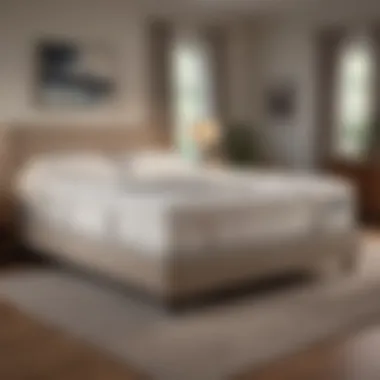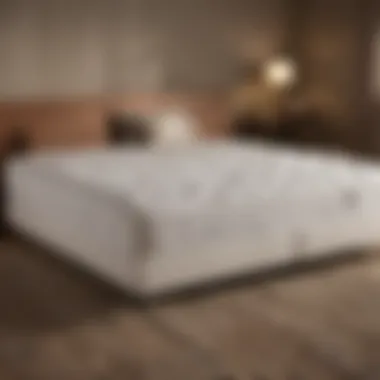Should Tempur-Pedic Mattresses Be Flipped? An In-Depth Analysis


Intro
Tempur-Pedic mattresses have gained a reputation for their unique feel and support, crafted from advanced memory foam technology. With the promise of comfort and durability, questions often arise regarding their maintenance, particularly when it comes to flipping them. Many people wonder if this practice is necessary or beneficial. Understanding how these mattresses are built, as well as what the manufacturers say, is crucial for consumers eager to extend their mattress life.
In this piece, we will explore the various aspects surrounding the practice of flipping Tempur-Pedic mattresses. This investigation will touch upon the actual construction materials involved, the manufacturer's recommendations, and the common myths that pervade consumer discussions about mattress care. By providing insight into proper maintenance, we aim to guide homeowners toward optimal sleep experiences and informed purchasing choices.
Key Insights and Trends
Understanding Mattress Construction
Tempur-Pedic mattresses typically consist of multiple layers of foam. The top layer, known as the comfort layer, is designed to contour the body, promoting better sleep alignment. Below that, the support layer provides the necessary firmness and durability.
These mattresses are not designed to be flipped. Unlike traditional innerspring mattresses, where rotation and flipping can enhance longevity, Tempur-Pedic mattresses offer a single-sided construction. Flipping them may disrupt their intended functionality, leading to a decline in comfort and support.
Manufacturer Recommendations
Tempur-Pedic itself advises against flipping their mattresses. This is because the materials are engineered for specific purposes on one side. To maintain warranty eligibility, owners should adhere to guidelines provided, which include rotating the mattress regularly. Many users have found that a simple rotation can help prevent uneven wear, preserving the structural integrity of the product.
"Flipping a Tempur-Pedic mattress is not recommended. Proper care includes regular rotations and keeping the surface clean." — Tempur-Pedic Customer Service
Insights on Sleep Quality
Various studies indicate that a well-maintained mattress can significantly affect sleep quality. Consumers might believe that flipping helps achieve a more consistent feel, but this often does not apply to memory foam designs. Instead, maintaining the mattress through proper cleanings, and avoiding undue stress by adhering to guidelines, can enhance sleeping quality.
Common Myths
There are several myths surrounding the flipping of memory foam mattresses:
- Myth 1: Flipping extends the life of a foam mattress.
- Myth 2: Flipping helps avoid sagging and indentations.
- Myth 3: All mattresses need to be flipped.
In reality, proper care methods, such as using a mattress protector and regular cleaning, have a more significant effect on longevity than flipping.
Practical Tips and How-To Guides
Proper Maintenance of Tempur-Pedic Mattresses
- Rotation: Rotate the mattress every 6 months to ensure even wear.
- Cleaning: Use a mild detergent and soft cloth to spot clean stains. Avoid soaking the foam.
- Protection: Use a quality mattress protector to guard against spills and allergens.
Additional Care Suggestions
- Support Base: Ensure your mattress is on a proper base that provides even support.
- Humidity Control: Keep the sleep environment well-ventilated to prevent moisture build-up.
By following these guidelines, homeowners can effectively enhance the lifespan and performance of their Tempur-Pedic products without resorting to ineffective methods like flipping.
Prelims to Tempur-Pedic Mattresses
Tempur-Pedic mattresses represent a fusion of innovation and comfort in the bedding industry. Understanding the nuances of these mattresses is important for homeowners, interior design enthusiasts, and anyone seeking to enhance their sleep environment. This section will lay the groundwork for discussing whether these specialized mattresses should be flipped, considering key factors such as comfort, durability, and maintenance.
Overview of Tempur-Pedic Technology
Tempur-Pedic technology is built on materials developed from memory foam. Originating from NASA's research in the 1970s, the property of viscoelastic foam allows the mattress to contour to an individual's body shape. This technology is designed to provide support and pressure relief, crucial for quality sleep. The slow recovery of the foam means it returns to its original shape after use, thereby enhancing the experience of users. Key elements of this technology include:
- Pressure relief: Reducing points of strain on the body can lead to more restful sleep.
- Motion isolation: This feature minimizes disturbances when one person moves, which is beneficial for couples sharing a bed.
- Durability: Tempur-Pedic mattresses are often more resistant to wear and tear due to their high-density foam composition.
In examining whether to flip these mattresses, understanding their unique construction and advantages helps inform best practices for maintenance.


Material Composition
The material composition of Tempur-Pedic mattresses is a significant factor in their performance. Each mattress typically includes multiple layers:
- Top layer: Often made of a breathable comfort layer that allows airflow, it promotes the regulation of temperature.
- Middle layers: These may consist of varying densities of Tempur foam, specifically designed to offer different levels of support and softness.
- Base layer: A stronger, denser support core provides the foundation, ensuring the longevity and stability of the mattress.
By integrating polyurethane and proprietary Tempur materials, these mattresses achieve a balance between plush comfort and strong support. However, the foam's structure also means that flipping is not recommended, as the design is specifically tailored to provide optimum comfort at the top surface. Understanding the structure of Tempur-Pedic mattresses allows consumers and users to make informed choices about their maintenance and overall care.
The Concept of Flipping Mattresses
Flipping mattresses has been a common practice in the past. Many people believed that doing so could prolong the lifespan of their sleeping surface. The importance of understanding this concept cannot be overstated. It opens up discussions about traditional versus modern mattress care methods. Moreover, it is essential to consider how this practice relates to specialized products like Tempur-Pedic mattresses.
Historical Practices in Mattress Care
In earlier times, mattresses were primarily made of materials like inner springs or feathers. These constructions allowed for flipping, as each side offered a different level of comfort and support. Homeowners frequently rotated or flipped their mattresses to prevent uneven wear. Such care was viewed as a standard practice, promoting familiarity with handling mattress maintenance.
However, as mattress technology evolved, so did care methods. Older types of mattresses could develop sagging or lumps if not flipped. This made flipping seem beneficial in managing longevity. Some families made it a routine to flip their beds each season or with changing weather cycles—this routine was ingrained in the maintenance culture of many households.
Current Trends in Mattress Maintenance
In contrast to the past, the approach to mattress care has shifted. Today's mattresses, especially memory foam designs like Tempur-Pedic, come with specific care guidelines. Most manufacturers recommend a different maintenance method, primarily focusing on rotation rather than flipping. The design of modern mattresses often means they are built to provide comfort and support on one side only. Their specialized material compositions can diminish performance if altered by flipping.
This modern trend has led to debates about the necessity of flipping. While some may still hold onto the practice out of habit, others question its relevance with current mattress designs. To enhance the durability and effectiveness of mattresses like Tempur-Pedic, proper care now often involves rotating the mattress rather than flipping it completely.
Tempur-Pedic Manufacturing Guidelines
Tempur-Pedic mattresses are renowned for their distinct construction and unique materials. This section explores the manufacturing guidelines established by Tempur-Pedic. Understanding these guidelines is vital for consumers who want their mattresses to perform at optimal levels. These guidelines encompass design features, official recommendations, and the science behind their structure. By adhering to these principles, users can extend the life of their mattress and enhance their sleeping experience.
Official Recommendations Against Flipping
Tempur-Pedic firmly advises against flipping their mattresses. This recommendation stems from the specific construction of their products. Unlike traditional mattresses that often have dual-sided designs, Tempur-Pedic mattresses are made with a single comfort layer. The comfort layer is designed to contour to the body, promoting proper alignment while sleeping.
Flipping the mattress can disrupt this design, negatively affecting sleep quality. The company highlights that such actions could lead to premature wear and reduced effectiveness in relieving pressure points. In addition to these performance concerns, flipping may also void warranties, which could result in costly replacements.
Key Points:
- Tempur-Pedic mattresses are designed for one-sided use.
- Flipping can damage the supportive properties of the mattress.
- Warranty may be compromised by improper care.
Design Features and Their Implications
The design of Tempur-Pedic mattresses is intricate, aimed at providing superior comfort and support. One prominent feature is the TEMPUR material, which adjusts to an individual’s body shape and weight. This material ensures that the mattress distributes weight evenly, reducing stress on critical areas like the hips and shoulders. With the absence of a flip-side, users are encouraged to focus on other maintenance techniques that maintain its performance.
The specific architecture, such as the firmness levels and thickness, enhances the sleeping experience. Moreover, the absence of springs contributes to reduced motion transfer, making it ideal for couples.
Impact of Flipping on Mattress Performance
Understanding the impact of flipping Tempur-Pedic mattresses is crucial for anyone looking to maximize their investment in sleep comfort. This section delves into how flipping, or the lack thereof, influences both sleep quality and the longevity of the mattress. The design and construction of Tempur-Pedic mattresses are specifically tailored to provide certain benefits. With this in mind, it becomes important to analyze how these benefits might be affected by the practice of flipping.
Effects on Sleep Quality
The quality of sleep can be directly connected to how a mattress performs over time. Tempur-Pedic mattresses utilize proprietary memory foam, which is designed to contour to the body's shape. When considering flipping, it’s essential to understand that the materials within these mattresses are engineered for a specific supportive experience.
People often believe that flipping a mattress can equalize wear and ensure consistent comfort. However, in the case of Tempur-Pedic models, flipping can disrupt the delicate balance of support and comfort that the layers provide. The sleeping surface is designed to function optimally on one side, which can lead to diminished support and discomfort if it’s flipped. This can ultimately result in poorer sleep quality due to pressure points exacerbated by incorrect usage.
Longevity and Wear Patterns


Another aspect to consider is the longevity of the mattress itself when flipping is attempted. Tempur-Pedic mattresses are constructed to sustain their shape over years of use without traditional flipping. When these mattresses are flipped, it can lead to irregular wear patterns, making the material break down more rapidly than intended.
Maintaining the performance of a Tempur-Pedic mattress should involve following the manufacturer's recommendations. By not flipping it, the consumer can avoid unnecessary wear and tear, thereby extending its usable life. In addition:
- Regular rotation (though not flipping) may help distribute body weight evenly.
- Keeping the mattress clean can also prolong its life.
- Using mattress toppers may provide additional support while preserving the original mattress design.
"Choosing to flip a Tempur-Pedic mattress may have unintended consequences on both comfort and durability."
In summary, while the idea of flipping mattresses is often associated with maintenance and care, it doesn't apply effectively in the context of Tempur-Pedic models. The focus should instead be on appropriate care methods that align with the construction intent. Understanding these factors is important for homeowners seeking the best sleep experience.
Debunking Myths About Flipping
The consideration of mattress maintenance often stirs many debates among consumers. One common topic that prevails is the concept of flipping mattresses, particularly for specialized ones like Tempur-Pedic. In this section, we will address misunderstandings surrounding this practice. Debunking these myths is essential, as it informs consumers on best practices for maintaining their mattress, ensuring longevity, and optimizing sleep quality.
Common Misconceptions
Many believe that flipping a Tempur-Pedic mattress enhances its lifespan and comfort. This misconception often arises from traditional mattress care practices where flipping was necessary to even out wear. However, Tempur-Pedic mattresses are designed uniquely. Flipping them can harm their construction and disrupt the intended comfort levels. It is crucial to recognize that these mattresses feature a one-sided design tailored to provide specific support and cushioning.
Another misconception is that flipping might alleviate sagging. However, sagging is a natural wear process in any mattress. It typically occurs after extended use, especially in mattresses with memory foam. Instead of flipping, maintaining the manufacturer's recommended care practices is more sensible for minimizing sagging.
Fact-Checking Popular Beliefs
Let’s clarify some widely held beliefs about mattress flipping:
- Belief: Flipping a mattress will enhance durability
- Belief: It is necessary to flip for optimal comfort
- Belief: Occasional flipping is good for hygiene
- Fact: For Tempur-Pedic, flipping can lead to uneven wear and reduce durability.
- Fact: These mattresses are engineered for comfort on only one side. Flipping alters the comfort layers.
- Fact: Regular cleaning methods are more effective. There is no significant benefit from flipping for hygiene.
The consensus from sleep experts is clear. Flipping Tempur-Pedic mattresses does not yield the benefits associated with other types of mattresses. Instead, it can lead to a decrease in comfort and possibly void warranties. It’s important for consumers to rely on factual information when considering their mattress care routine.
"Understanding the distinct features of your mattress can make a significant difference in its performance and your overall sleep experience."
This knowledge empowers owners to make informed decisions regarding the care of their Tempur-Pedic models.
Alternative Methods for Mattress Maintenance
Maintaining a Tempur-Pedic mattress requires an understanding of its unique construction and properties. Instead of flipping, there are alternative maintenance methods that can enhance its durability and comfort. These practices are essential for consumers who wish to extend the life of their investment.
Rotate vs. Flip
Rotating a mattress refers to turning it 180 degrees, so the head becomes the foot. This practice is beneficial for an even wear pattern, particularly for traditional innerspring mattresses. However, Tempur-Pedic mattresses are designed without a top or bottom layer. Therefore, flipping them over is not recommended and could lead to discomfort or damage. Rather, it is advisable to rotate a Tempur-Pedic mattress every three to six months. This simple practice helps in prolonging the mattress's lifespan while ensuring more uniform wear without compromising its integrity.
Regular Cleaning Techniques
Cleaning your mattress is crucial for maintaining hygiene and preventing dust mites and allergens. Regular cleaning can significantly enhance sleep quality. Here are effective techniques for cleaning a Tempur-Pedic mattress:
- Vacuum: Use a handheld vacuum with an upholstery attachment to gently remove dust and debris from the surface. Regular vacuuming can reduce allergens that may accumulate over time.
- Spot Clean: For stains, use a mild detergent mixed with water. Apply the solution with a soft cloth and blot, rather than scrub, to avoid damaging the memory foam.
- Air Out: Periodically allow your mattress to air out by removing bedding. This helps minimize odors and excessive moisture.
Using Mattress Protectors
Investing in a quality mattress protector is a wise decision for any Tempur-Pedic owner. A protector can serve multiple purposes:


- Prevent Stains: It shields the mattress from spills and stains, thereby preserving its original appearance.
- Reduce Wear: It can absorb sweat and other potential damaging substances, helping to maintain the mattress’s structural integrity.
- Allergen Barrier: Many protectors are designed to be hypoallergenic, which can help in reducing exposure to allergens while sleeping.
Using a mattress protector can significantly extend the life of your Tempur-Pedic mattress by preventing damage and reducing the need for deep cleaning.
Consumer Experiences and Testimonials
Consumer experiences play a crucial role in assessing whether Tempur-Pedic mattresses should be flipped. User opinions reflect real-life interactions with the product, including how flipping affects comfort and longevity. Feedback from actual customers provides insights into the daily use of mattresses, presenting a practical perspective often overlooked in manufacturer guidelines. Evaluating these testimonials allows potential buyers to make informed decisions based on genuine experiences rather than theoretical suggestions.
User Feedback on Flipping
User feedback regarding the practice of flipping Tempur-Pedic mattresses varies significantly. Many consumers have reported that flipping their mattresses does not produce the desired effects such as enhanced comfort or improved sleep quality. In some cases, users expressed issues like uneven surfaces or discomfort from improper usage.
- Some users feel that their mattress's performance declined after attempting to flip it, citing reasons such as uneven wear patterns and reduced support.
- Others reported satisfaction from sticking to the manufacturer’s recommendations, stating they experienced consistent comfort and durability without the need for flipping.
It's essential to consider these varied experiences because they highlight individual preferences and the subjective nature of comfort. Not everyone may react the same way to a mattress, hence personal accounts are valuable in the overall analysis.
Case Studies
Case studies further solidify the importance of consumer experiences. In-depth analysis of specific user scenarios reveals significant variation in outcomes when mattress flipping is involved. For instance, a study was conducted on a group of twenty Tempur-Pedic users, focusing on those who flipped their mattresses versus those who maintained standard practices.
- Of the group who flipped their mattresses, only 30% reported an improvement in sleep quality.
- Conversely, those who adhered to standard usage without flipping reported an 80% satisfaction rate with sleep quality.
Such findings suggest a clear disparity where most users experienced better results by following manufacturer guidelines. It also encourages others to consider empirical data over general misconceptions.
Professional Opinions on Mattress Flipping
The question of mattress flipping often stirs debate among consumers and industry professionals alike. In the case of Tempur-Pedic mattresses, the discourse gains particular importance due to the specialized nature of their materials and construction. Understanding what professionals recommend can help illuminate the best care practices for these products, ultimately affecting their longevity and user satisfaction.
Insights from Sleep Experts
Sleep experts generally emphasize the correlation between a mattress's design and the necessity of flipping. Tempur-Pedic mattresses are crafted with a unique viscoelastic foam that is designed to contour to the sleeper's body. This firm construction does not require the traditional flipping method found in older mattress models. In fact, sleep experts often advise against flipping, as the materials are not designed to perform evenly on both sides.
Many experts suggest that instead of flipping, consumers should focus on rotating their mattresses periodically. This can help mitigate uneven wear and maintain a comfortable sleep surface.
Moreover, a survey conducted among sleep specialists reveals a consensus that long-term comfort depends not on flipping but on ensuring proper support. The performance of a Tempur-Pedic mattress can be compromised by an inappropriate flipping practice. Thus, recommendations often point toward
- rotating the mattress 180 degrees every few months.
- adhering to the manufacturer's guidelines.
- regularly checking for any signs of wear, especially on the surface that is frequently in contact with the sleeper.
Manufacturer Expert Advice
Manufacturer insights play a critical role in understanding the maintenance of Tempur-Pedic mattresses. Tempur-Pedic explicitly advises against flipping their products. The construction of these mattresses includes specific layers that serve distinct functions. Flipping would disrupt this layered system, leading to decreased performance and comfort.
Experts from Tempur-Pedic articulate that the top layer is the primary unique feature. The top layer's material is crafted to provide pressure relief and breathability. When this layer is subjected to excessive flipping, it may degrade faster and lose the supportive benefits intended for the user.
In summary, both sleep experts and manufacturer representatives underscore the recommendation against flipping Tempur-Pedic mattresses. Consumers are urged to follow alternative maintenance practices, which can lead to improved sleep quality and prolonged product life.
End
Understanding whether Tempur-Pedic mattresses should be flipped requires careful consideration of the unique design and materials used in these products. Tempur-Pedic mattresses utilize viscoelastic foam, which is formulated to respond to pressure and temperature. Due to this specific composition, flipping the mattress may not only be unnecessary but can also lead to adverse effects on its performance.
Summary of Key Findings
In this analysis, several critical points emerged regarding the flipping of Tempur-Pedic mattresses:
- Design and Structure: These mattresses are designed with a specific top layer that conforms to the body's shape. Flipping could disrupt this intended functionality.
- Manufacturer Guidance: Tempur-Pedic explicitly recommends against flipping their mattresses. This advice is rooted in extensive testing and the proprietary nature of their foam technology.
- Performance Impact: Flipping may impact the durability and comfort, potentially leading to premature wear or loss of support.
- Maintenance Practices: Instead of flipping, rotating the mattress regularly (every three to six months) ensures even wear and can improve overall lifespan without compromising comfort.
Final Recommendations for Consumers
Based on the findings, the following recommendations can help consumers maintain the integrity and longevity of their Tempur-Pedic mattresses:
- Avoid Flipping: As per manufacturer guidelines, refrain from flipping the mattress. This practice does not align with its designed use and may cause damage.
- Regular Rotation: Rotate the mattress every few months to even out wear on the sleeping surface. This simple action can prolong its life.
- Protect the Mattress: Consider using a mattress protector to guard against spills, stains, and allergens.
- Maintain Cleanliness: Regularly clean and vacuum the mattress surface to remove dust and debris, enhancing both hygiene and comfort.



